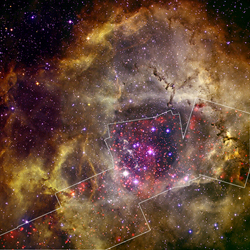Massive Stars (con't.)
This image of N44F captures the gas cavity carved by the stellar wind and intense ultraviolet radiation from a hot young star. This young star was once buried deep within a cold dense molecular cloud. The cloud fragmented and condensed, forming a core which became a protostar. Eventually the protostar became hot enough for thermonuclear fusion to begin, and the hydrogen nuclei in the core started fusing into helium nuclei. After the core hydrogen has been depleted in these massive stars (greater than ~8 solar masses) helium begins fusing into carbon and oxygen nuclei. The carbon-oxygen core contracts and heats until it is hot enough for carbon and oxygen to start the fusion process. Their fusion yields neon, magnesium, silicon, and sulfur nuclei. Eventually, silicon and sulfur fuse in the star's core to form iron, nickel, and other nuclei of similar atomic weight.

The star's structure now resembles an onion. The central core of the onion consists of iron nuclei. Surrounding the core is a shell in which silicon and sulfur are fusing, adding more iron nuclei to the iron core. In additional levels further out, lighter elements fuse - oxygen, carbon, helium, and hydrogen. The iron core is very compact and cannot ignite to induce further nuclear fusion. Nuclear fusion, just like chemical burning, is possible only if the reactions release energy. The fusion of iron with other nuclei to make still heavier nuclei requires an input of energy - it is an endothermic reaction. The energy required to manufacture elements heavier than iron becomes available only during the catastrophic collapse of the star's core and the violent expulsion of the star's outer envelope that is about to occur. The cluster of hot stars in the lower right corner of Hodge 301, located within the Tarantula Nebula, is rapidly approaching collapse. This massive star-forming region is in the Large Magellanic Cloud, a galaxy ~180,000 LY away. As the hydrogen fuel begins to run out, these massive stars leave the main sequence of the H-R diagram and start evolving towards the supergiant branch. The transition to the supergiant branch is not smooth, and the stars expand and contract as the fusion process changes from one type of nuclei to the next. Many of these stars pulsate because they are not in hydrostatic equilibrium: the force of gravity acting on the outer mass of the star is not quite balanced by the interior radiation pressure pushing outwards. If a star expands as a result of increased gas pressure, the material density and pressure decrease until the point that hydrostatic equilibrium is reached and then overshot, owing to the momentum of the expansion. At this point the star is transparent and photons can escape. Then gravity dominates, and the star begins to contract. The momentum of the infalling material carries the contraction beyond the equilibrium point. At this point the star becomes opaque and photons are trapped and the star is dimmer. The pressure again becomes too high, and the cycle starts over again. The star acts as an oscillator. This type of star is called a variable star, because the star changes its brightness, or magnitude, as it pulsates. One type of massive pulsating variable star is called a Cepheid. Most massive stars pass through the Cepheid instability strip of the H-R diagram as they transition to the red supergiant branch.
Cepheids have a repeating cycle of change that is periodic - as regular as the beating of a heart. Observations of the changes in apparent magnitude of variable stars - including Cepheids - are plotted as the apparent magnitude versus time, usually in Julian Date (JD). The resulting graph is called a light curve. The light curve for the Cepheid variable star X Cyg (located in the constellation Cygnus) is shown below. Each data point represents one observation. Once many observations have been plotted, important information can be obtained from the resulting pattern of changing magnitudes. The period for X Cyg is the amount of time it takes for the star to go through one complete cycle from maximum magnitude (brightness), through minimum magnitude (dimmest), and back to maximum magnitude (brightness.)





